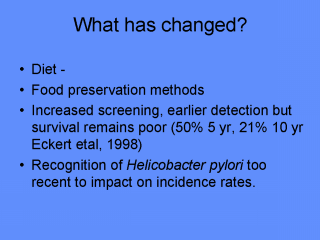| front |1 |2 |3 |4 |5 |6 |7 |8 |9 |10 |11 |12 |13 |14 |15 |16 |17 |18 |19 |20 |21 |review |
 |
In explaining
the declines in stomach cancers, we need to consider what factors have changed, and the
plausibility of those factors as potential causal agents. The first and most obvious factor to consider is diet. As most of these countries became industrialized following the second world war, wealth increased and a wider range of foodstuffs became available. Dietary change included and were gradually replaced by fresher foods, and non-traditional foods, which were more readily available throughout the year, due to improvements in national and international transportation, agriculture and trade. However, the change in diet has been associated with a shift in the location of cancers from the upper to the lower GI tract. Food preservation have moved away from traditional forms of food preservation, such as pickling, smoking and salting, methods to canning, refrigeration and more recently, vacuum packing. These have lead to a reduction in exposure to carcinogenic by-products of traditional dietary preservation methods, such as nitrosamines. While screening for gastric cancers have been improved, leading to earlier detection, survival from stomach cancers remains poor. Recent recognition of the role of H.Pylori in gastric cancer has only recently been recognized, and treatment of H.Pylori infection has not yet had chance to impact of gastric cancer prevalence. |
| front |1 |2 |3 |4 |5 |6 |7 |8 |9 |10 |11 |12 |13 |14 |15 |16 |17 |18 |19 |20 |21 |review |